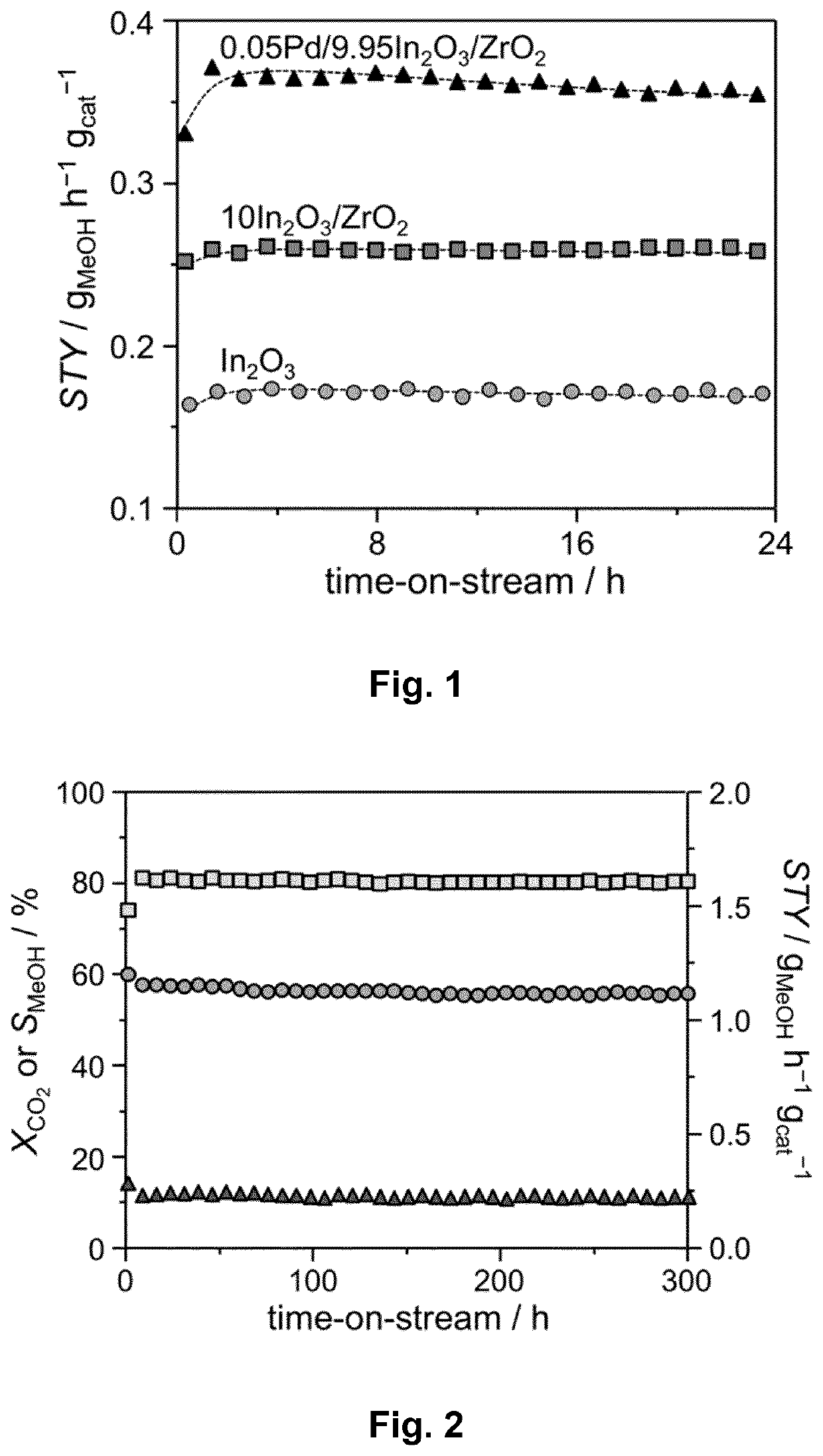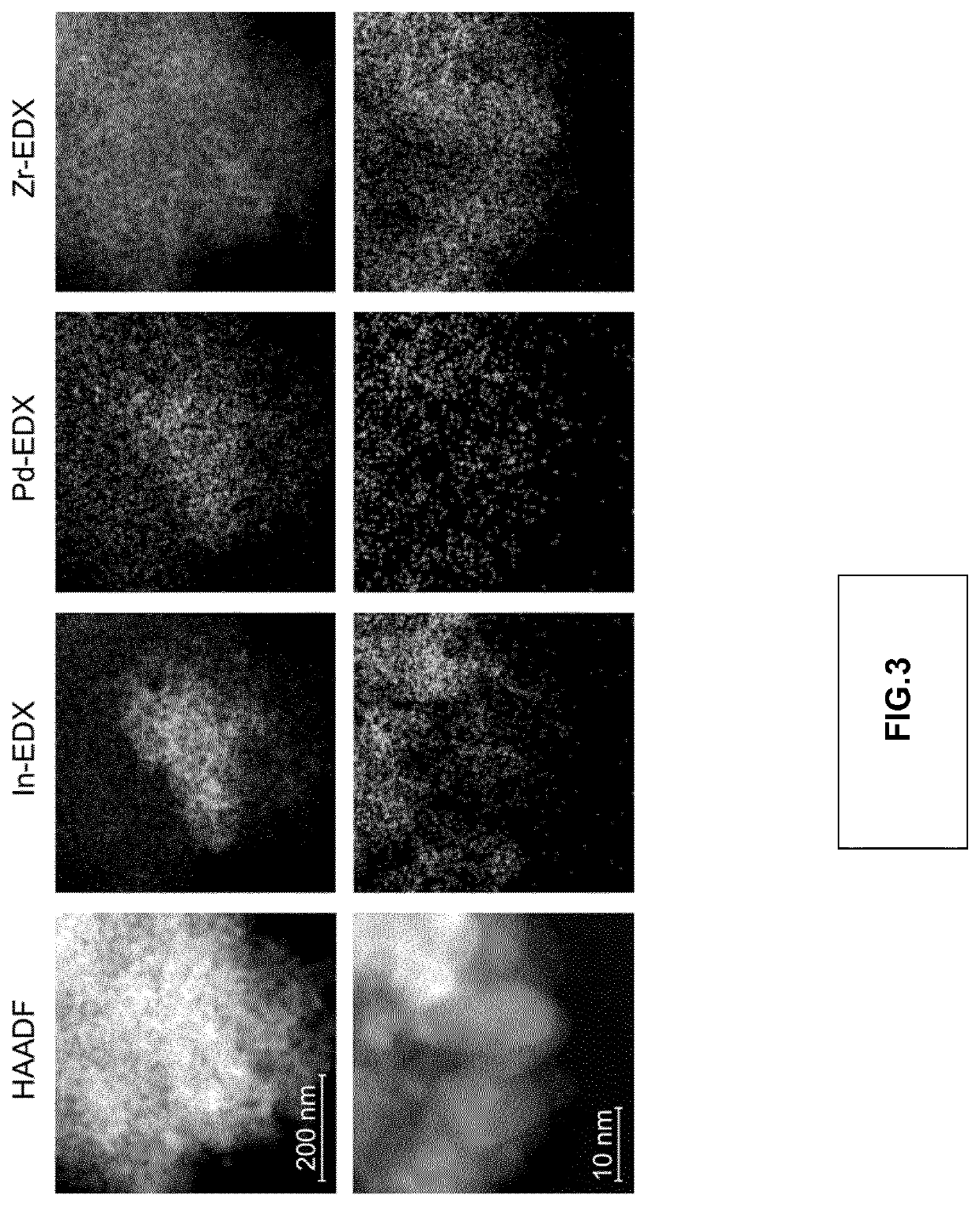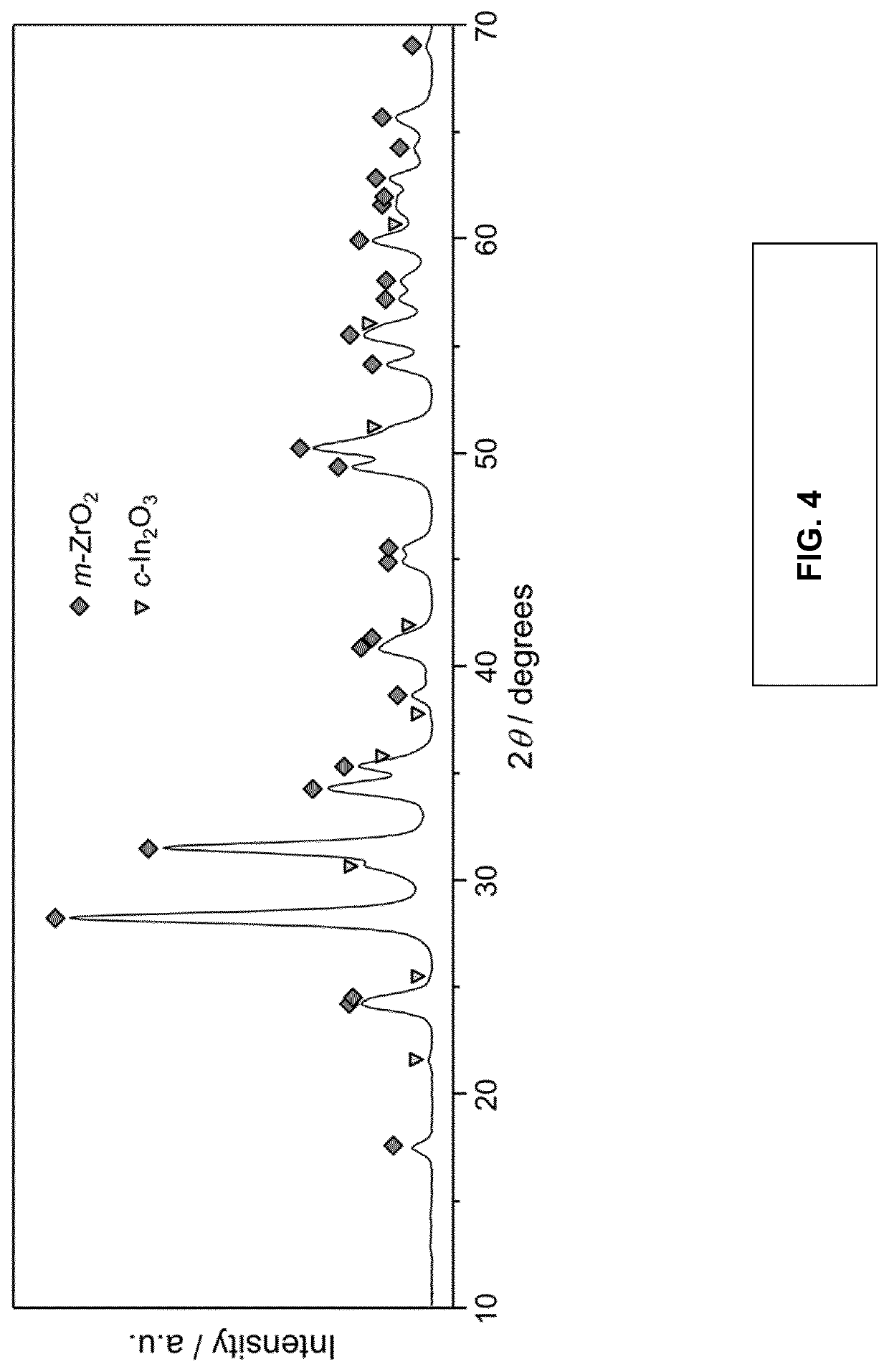Noble metal promoted supported indium oxide catalyst for the hydrogenation of co2 to methanol and process using said catalyst
- Summary
- Abstract
- Description
- Claims
- Application Information
AI Technical Summary
Benefits of technology
Problems solved by technology
Method used
Image
Examples
example 1
Synthesis
Wet Impregnation (WI)
[0123]To obtain 9.5 wt. % In203 and 0.5 wt. % Pd on ZrO2, In(NO3)3.xH2O (0.821 g, Sigma-Aldrich, 99.99%) and Pd(NO3)2.xH2O (0.014 g, Sigma-Aldrich, >99.99% metals basis) were placed in a 250-cm3 round-bottom flask and dissolved in deionized water (100 cm3). Then ZrO2 (3.00 g, Alfa Aesar, 99.9% metals basis excluding Hf) was added and the slurry was stirred at room temperature for 30 min. The water was then removed using a rotary evaporator (100 rpm, 313 K, 8 kPa, ca. 90 min) and the sample was further dried in a vacuum oven (1.5 kPa, 323 K, ca. 90 min). Thereafter the sample was calcined at 573 K (2 K min−1) for 3 h static air.
Coprecipitation (CP)
[0124]To obtain 9.9 wt. % In203 and 0.1 wt. % Pd on ZrO2, In(NO3)3.xH2O (0.57 g), Pd(NO3)2.xH2O (0.01 g), and zirconyl nitrate solution (9.67 g, Sigma-Aldrich, 35 wt. % in dilute nitric acid) were placed with 70 cm3 of deionized water in a 250-cm3 round-bottom flask. A 10 wt. % Na2CO3 solution was prepared by d...
example 2
Testing
[0129]Different catalytic system including Pd / In2O3 / ZrO2 of various Pd loadings were evaluated in a methanol synthesis reaction, the results are given in Table 1.
[0130]From this table it can be seen that the presence of palladium improves the STY by comparison to system without palladium, when applied using the correct synthesis method.
TABLE 1Catalyst testing, all samples were measured at 280° C.,5.0 MPa, molar H2:CO2 = 4, WHSV 24,000 cm3STP gcal−1 h−1.SynthesisTcalcinationTemperaturePdnominalIn2O3,nominalXCO2SMeOHSTYMeOHCatalystmethod[K][K][wt. %][wt. %][%][%][gMeOHgcal−1h−1]Ga2O3—Pd / SiO2aIW6735232.02.6b13.070.0 0.25310 In2O3 / ZrO2WI5735530.010.004.879.00.26Pd—In2O3CP573 553a 0.7599.2511.578.00.669.5 / 0.5 In2O3—Pd / ZrO2WI5735530.59.506.978.80.379.9 / 0.1 In2O3—Pd / ZrO2CP5735530.19.900.0—0.009.5 / 0.5 In2O3—Pd / ZrO2SG5735530.59.501.398.60.099.9 / 0.1 In2O3—Pd / ZrO2DP5735530.19.905.275.60.279.9 / 0.1 In2O3—Pd / ZrO2DP7735530.19.906.177.80.339.0 / 1.0 In2O3—Pd / ZrO2DP5535531.09.0012.175.90.639.0 / ...
example 5 stability
of the Catalyst of the Present Invention
[0135]FIG. 1 reports the catalytic data collected during a 24-h test to evaluate the stability of the Pd / In2O3 / ZrO2 catalytic system (0.05 wt. % Pd loading) of the present invention and to compare it with the stability of the corresponding catalytic system devoid of palladium (In2O3 / ZrO2) and unsupported (In2O3).
[0136]Reaction conditions: 553 K (279.85° C.), 5.0 MPa, 24,000 cm3STP gcat−1 h−1, 0.1 g of catalyst, molar H2:CO2=4:1.
[0137]After an initial STY above 0.30 gMeoH gcat−1 h−1, a quick rise in the productivity (STY) to reach a STY of 0.36 gMeoH gcat−1 h−1 has been observed in the first hour of the reaction. Thereafter, the productivity of the catalyst stays unaltered. By comparison with the supported catalyst devoid of palladium, the productivity (STY) was around 1.5-times higher when palladium is present. The STY of the bulk oxide (In2O3) is on the other hand around 2.5-times lower when compared to the STY of the ternary catalytic system...
PUM
| Property | Measurement | Unit |
|---|---|---|
| Temperature | aaaaa | aaaaa |
| Temperature | aaaaa | aaaaa |
| Temperature | aaaaa | aaaaa |
Abstract
Description
Claims
Application Information
 Login to View More
Login to View More - R&D
- Intellectual Property
- Life Sciences
- Materials
- Tech Scout
- Unparalleled Data Quality
- Higher Quality Content
- 60% Fewer Hallucinations
Browse by: Latest US Patents, China's latest patents, Technical Efficacy Thesaurus, Application Domain, Technology Topic, Popular Technical Reports.
© 2025 PatSnap. All rights reserved.Legal|Privacy policy|Modern Slavery Act Transparency Statement|Sitemap|About US| Contact US: help@patsnap.com



